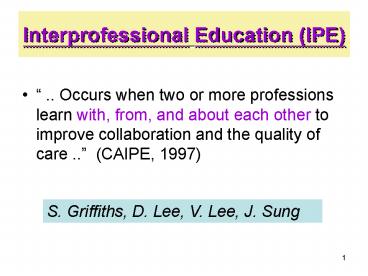Interprofessional Education IPE PowerPoint PPT Presentation
1 / 21
Title: Interprofessional Education IPE
1
Interprofessional Education (IPE)
- .. Occurs when two or more professions learn
with, from, and about each other to improve
collaboration and the quality of care ..
(CAIPE, 1997)
S. Griffiths, D. Lee, V. Lee, J. Sung
2
Interprofessional Education (IPE)
- Is there a real need?
- If so, should this Faculty introduce IPE in the
near future? - How should we coordinate IPE among our programs
in Nursing, Pharmacy, Public Health and Medicine? - What, if any, are the global student learning
outcomes for Nursing, Pharmacy, Public Health and
Medicine in light of these decisions?
3
Interprofessional Education (IPE)
- Is there a real need? YES
- If so, should this Faculty introduce IPE in the
near future? YES - How should we coordinate IPE among our programs
in Nursing, Pharmacy, Public Health and Medicine?
Office of Educational Services - What are the global student learning outcomes..?
4
Five Competencies Required of Health
Professionals in Assuring Patient Safety
- Delivering patient-centered care
- Working as part of interdisciplinary teams
- Practicing evidence-based medicine
- Focusing on quality improvement
- Using information technology
- Health Professions Education Bridge to Quality
(2003)
5
Interdependent
Need to train health professionals to practice
collaboratively
Need teaching settings with health professionals
who practice collaboratively
6
Agenda (230-315 p.m.)
- IPE A holistic model of health professional
education (V. Lee) - Common approaches A shared need
- (S. Griffiths)
- Cadenza training program (community-based) (D.
Lee) - Collaborative practice (hospital-based)
- (J. Sung)
7
Agenda (340-430 p.m.)
- Current situation in the teaching of common
science courses - Next step Working group
- Impact on profession-specific curriculum
- Elective or required?
- Format?
- Logistics issues
- Resources
- Demonstration project?
8
Objectives
- To promote the active participation of each
profession in patient care, - To optimize staff participation in clinical
decision making within and across disciplines - To foster respect for disciplinary contributions
of all professionals - To provide mechanisms for continuous
communication among care-givers and health
professionals
9
Goal
- To change the way we educate healthcare providers
to ensure they have the necessary knowledge,
skills, and attitudes to work effectively in
interprofessional teams within the evolving
healthcare system.
10
Health Professional Learner Competencies
11
Strategy
- Develop a context in which learning together
becomes a vital part ofworking together - Go beyond silo style of training
- Create an early opportunity for students from
different professions to explore a variety of
issues
12
Features of Interprofessional Programs
- A combination of didactic and clinical
instruction - Explicit attention to non-clinical skills
communication, group, and conflict resolution
skills - Non-traditional interprofessional problem-based
learning strategies
13
J Interprofessional Care, 2005
14
Possible Formats
- Courses
- Clinical rounds
- Seminars
- Interprofessional day on a timely topic
Disease-focused forum - Case-based simulated learning
15
Requirements for Implementation
- Support from the top
- A dedicated core faculty drawn from existing
disciplinary faculty - Facilitation time for students who wish to
participate - Formal and informal student interaction outside
of discipline barriers, through student
organizations - The establishment of strong community
partnerships, along with recognition of the role
that community plays in the practice education of
students
16
Interdependent
Need to train health professionals to practice
collaboratively
Need teaching settings with health professionals
who practice collaboratively
17
Barriers to Interprofessional Education
- Culture
- Professional identity
- Accountability and expectations
- Clinical responsibility
- Academic schedule and load
- Availability of interprofessional education
expertise and of educational content
18
Curricula Comparison
19
Status
- Few well controlled studies
- Mixed results
- Little direct evidence for persistent improvement
or behavior change among learners
20
UCSF IPE Pilot Initiative 2008
- Pharmacy students shadowed medical students
- Responsibilities, priorities, and pressures of
the medical student learning experience - Different levels. Expectations and perspectives
within medicine - Collaboration of nursing and medical perspectives
on patient care
21
Outcomes
- Improved efficiency, quality and safety of
patient care - .. The right healthcare professional doing the
right job at the right place.. - CUHK differentiates

